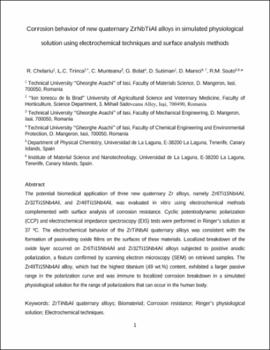Corrosion behaviour of new quaternary ZrNbTiAl alloys in simulated physiological solution using electrochemical techniques and surface analysis methods
Date
2017Abstract
The potential biomedical application of three new quaternary Zr alloys, namely Zr6Ti15Nb4Al, Zr32Ti15Nb4Al, and Zr49Ti15Nb4Al, was evaluated in vitro using electrochemical methods complemented with surface analysis of corrosion resistance. Cyclic potentiodynamic polarization (CCP) and electrochemical impedance spectroscopy (EIS) tests were performed in Ringer’s solution at 37 ºC. The electrochemical behavior of the ZrTiNbAl quaternary alloys was consistent with the formation of passivating oxide films on the surfaces of these materials. Localized breakdown of the oxide layer occurred on Zr6Ti15Nb4Al and Zr32Ti15Nb4Al alloys subjected to positive anodic polarization, a feature confirmed by scanning electron microscopy (SEM) on retrieved samples. The Zr49Ti15Nb4Al alloy, which had the highest titanium (49 wt.%) content, exhibited a larger passive range in the polarization curve and was immune to localized corrosion breakdown in a simulated physiological solution for the range of polarizations that can occur in the human body






